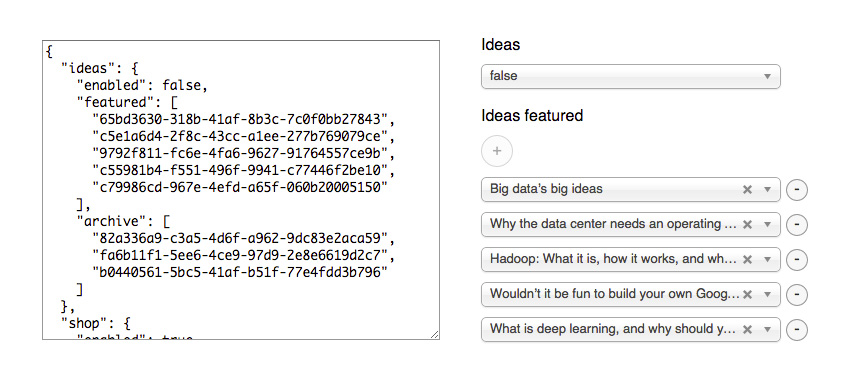https://github.com/oreillymedia/jsonform
JS library for building JSON objects through a dynamic form
https://github.com/oreillymedia/jsonform
Last synced: 3 months ago
JSON representation
JS library for building JSON objects through a dynamic form
- Host: GitHub
- URL: https://github.com/oreillymedia/jsonform
- Owner: oreillymedia
- Created: 2015-03-28T00:39:28.000Z (over 10 years ago)
- Default Branch: master
- Last Pushed: 2015-06-09T16:31:51.000Z (about 10 years ago)
- Last Synced: 2025-03-21T08:51:20.175Z (4 months ago)
- Language: JavaScript
- Size: 391 KB
- Stars: 17
- Watchers: 18
- Forks: 4
- Open Issues: 2
-
Metadata Files:
- Readme: README.md
Awesome Lists containing this project
README
# JSON form

This is a javascript library that can auto-generate a form to help a user generate a JSON document.
The library takes a textarea DOM element (empty or filled with existing JSON data), and a JSON object that describes the JSON you want to manipulate via the form.
```js
var config = {
...
}
var jf = new jsonform.Form($("#myTextField")[0], config);
```
## The config object
The config object defines the outline of the JSON object that the library should generate. You can use any type of object: The only requirement is that whereever you need dynamic data input, you create an object with the property `jsType` set to the type of field you want in the form.
The following json config shows a single textfield to the user:
```js
var config = {
"name" : {
"jfType" : "StringField"
}
}
```
The user will then be presented with a single textfield, and the original textarea will automatically update with the latest JSON representation:
```html
{
"name" : "whatever the user typed"
}
```
Although that's a very simple use-case, the library supports a number of advanced fields. Look in the field parameters guide below.
But what if you want the user to add more than a single name? Easy. Wrap your `jfType` object in an array, and the UI will show buttons to add/remove multiple fields. For example, this is a more complex example where a user can add up to 7 names:
```js
var config = {
"names" : [
{
"jfType" : "StringField",
"jfMax" : 7
}
]
}
```
Corresponding output:
```html
{
"names" : [
"whatever the user typed",
"whatever the user typed"
"whatever the user typed"
"whatever the user typed"
"whatever the user typed"
]
}
```
If the textarea has existing JSON data, and that data matches the schema of the JSON config, the existing JSON values will be pre-filled into the form.
Look in `test/index.html` for a more complicated JSON config structure.
## Optional Configuration
If you want the collection fields to be sortable, you just need to add `jquery.sortable` to the page. See `/examples/sortable.html` for an example.
## Field parameters
There's a number of fields in this library, each of them with specific parameters. These params apply to all fields:
```js
{
"jfType" : "XXXXField", // name of field to use
"jfTitle" : "My title", // label to show before the input field(s)
"jfHelper" : "Do this, do that", // smaller help text to show before the input field(s)
"jfValueType" : "int" // force the value to be integer over string. Helpful for text input, etc.
}
```
### BooleanField
No specific options. Will show a select box with `true` or `false`.
```js
{
"jfType" : "BooleanField"
}
```
### StringField
No specific options. Will show an input text field.
```js
{
"jfType" : "StringField"
}
```
### SelectField
Will show a select field with options set from `jfValues`.
```js
{
"jfType" : "SelectField",
"jfValues" : [["first", "First Item"], ["second", "Second Item"]]
}
```
### AjaxField
Will show a search box that queries against an API endpoint, and populates the results in a dropdown box. It also supports parsing existing data into the dropdown, via the `jfReloadParam`.
```js
{
"jfType" : "AjaxField",
"jfUrl" : "http://my.api", // URL for API endpoint
"jfSearchParam" : "search", // query param to use for search query (http://my.api?search=QUERY)
"jfParse" : function(data, vals) { }) // Parse function that receives the API response. Should return an array of [value, label] arrays for the select box. Takes an optional parameter with single values from existing JSON, to use for sorting. Look in test/index.html for an example.
"jfReloadParam" : "uuid[]", // used to populate existing data. A single request will be made with all values set to this array param, and the parse function will be used to populate the fields from the response. Look in test/index.html for an example.
}
```
### SelectAjaxField
Will show a select dropdown box, and whenever a value is selected, an ajaxfield below that searches a specific endpoint. This makes it possible to make a fields where the user first selects the type of API endpoint, and then searches for a specific object in that endpoint. See examples for more info.